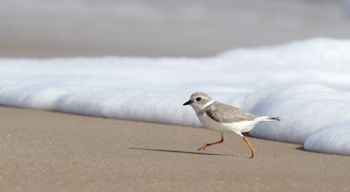WILMINGTON – Pressed by environmental groups, the federal agency that oversaw a study of the proposed terminal groin on Figure Eight Island has decided to take another look at the structure after property owners submitted a new design and location that aren’t included in the original study.
The Army Corps of Engineers will update its 2012 draft Environmental Impact Statement, or EIS, of the proposed groin at Figure Eight’s north end. The amended version will give the public the opportunity to review and comment on the new design and location that’s now preferred by the private island’s homeowners association’s board of directors.
Supporter Spotlight
“Instead of going out with a final (EIS) as we were planning on doing several months ago we just saw a need to go out with a supplement to the draft EIS,” Mickey Sugg, project manager with the Corps’ Wilmington office, said yesterday. “We felt it was beneficial to the public to give them another opportunity to review the project. Basically you can look at it as an updated draft.”
The decision to supplement the study comes more than a year after the Figure Eight Island Homeowners Association’s board agreed on a revised project alternative well after the public comment period ended for draft study.
 Todd Miller |
The preferred design is a longer, bigger structure a little more than 400 feet further north from alternatives listed in the original study.
“They (the homeowners) came back with two additional structure options basically moving it 400 feet to the north,” Sugg said. “We looked at that not so much as a new alternative, but a minor variation of an existing alternative. It’s not something that was so brand new and it was not so totally different than what was looked at in the draft.”
The N.C. Coastal Federation and other environmental groups began pressing the Corps more than a year ago to restart the environmental review process to adequately assess changes that they considered to be significant.
Supporter Spotlight
Todd Miller, the executive director of the federation, was happy to hear that the Corps was taking another look at the project. “The draft EIS released in 2012 was based upon 2006 data. Over the past eight years the inlet changed dramatically in ways not predicted by the draft EIS, and there is now about 60 acres of new land on the north end of Figure Eight Island,” he said. “The previously issued draft study is completely obsolete given the changes in circumstances at the inlet.”
The proposed rock groin would be 80 feet wide and extend 1,200 feet across the beach and into the ocean. About 300 feet would cross coastal wetlands.
The federation is working with other environmental groups on the “Save Rich Inlet” campaign, which aims toeducate Figure Eight property owners and surrounding communities about the possible environmental implications a terminal groin would have on the inlet, the island and other shorelines.
In a letter sent to the Corps several weeks ago by the Southern Environmental Law Center on behalf of the federation and Audubon North Carolina, the groups also requested that the Corps start the required consultation with the U.S. Fish and Wildlife Service about threatened and endangered species that use the inlet as critical habitat.
“We were informed by the Corps yesterday that this review as required by the federal Endangered Species Act will begin shortly,” said Miller. “The results of this review are likely to have a major bearing on what can be allowed at the inlet.”
Among the groups’ concerns is the nearly 60-acre stretch of unspoiled beach that reaches into the natural inlet. This sandy area is critical habitat to thousands of shorebirds, including some that are protected under federal law. According to projections by the engineers hired by the island’s homeowners, the spit will be swallowed by the Atlantic if a terminal groin is built. The north end of Figure Eight Island has been monitored intensely by Audubon in recent years and is rated as some of the most valuable and productive shorebird habitat in the Eastern U.S.
 The Army Corps of Engineers will begin consultations with the U.S. Fish and Wildlife Service on the proposed groin’s effects on endangered or threatened species, such as the piping plover. Photo: Sam Bland |
But the island’s homeowners association leaders argue that a terminal groin is the best option to protect the north end from erosion.
David Kellam, administrator of Figure Eight Island, said yesterday that he is confident the Corps “is doing the right thing.”
“It has been our intent to do it the right way and do all the right things throughout this whole process,” he said. “The end product is going to be very beneficial for everyone so we certainly want to ensure that everything is done to the best of everyone’s capabilities.”
Some of the property owners whose land is on the north end of the island have refused to grant the association the easements it would need to build the groin across their property. Figure Eight is unincorporated, and the homeowners association doesn’t have the legal authority to condemn property.
It remains unclear how many of those property owners continue to hold out. Kellam declined to go into specifics.
“We certainly hope that once the members on the island are educated and informed and see the benefit of a long-term management plan for the north end of the island that they will, in fact, be very glad they have a long-term management plan to assist in maintaining the island in the future,” he said.
Sugg said federal regulations do not require applicants to have easements before the Corps issues a permit for a project.
The project will have to apply for a permit that is jointly issued by the N.C. Division of Coastal Management and the Corps, Miller explained. “N.C. regulations prohibit the state from accepting such a permit application until all property owners agree to allow the project to be constructed on their private properties,” he said. “This means that as long as property owners refuse to grant easements for the project, the Corps will not be issuing any permits for a terminal groin at Figure Eight Island.”
The supplemental draft EIS will likely be published sometime before Christmas or shortly after the New Year, Sugg said. Once the draft is released there will be a 45-day public comment period.
“When the supplement goes out what we’ll do is very similar to the draft,” he said. “We’ll receive all the comments, we’ll pore through them and make adjustments to the EIS. Then, after that, we’ll start preparing for the final EIS to be released.”
He stressed that a final EIS is not a permit. “We use our EIS to help us make our permit decision,” he said.
He said the final study may be released by mid-summer next year.
Figure Eight Island is one of four N.C. beach communities planning to build terminal groins since the N.C. General Assembly in 2010 legalized up to four such structures.
The Village of Bald Head Island in Brunswick County was the first to receive a state permit to build a terminal groin there. The N.C. Department of Environment and Natural Resources issued the Coastal Area Management Act major permit in October.
Two other Brunswick County beach towns – Holden Beach and Ocean Isle Beach – are in varying stages of the environmental review required by federal law.







